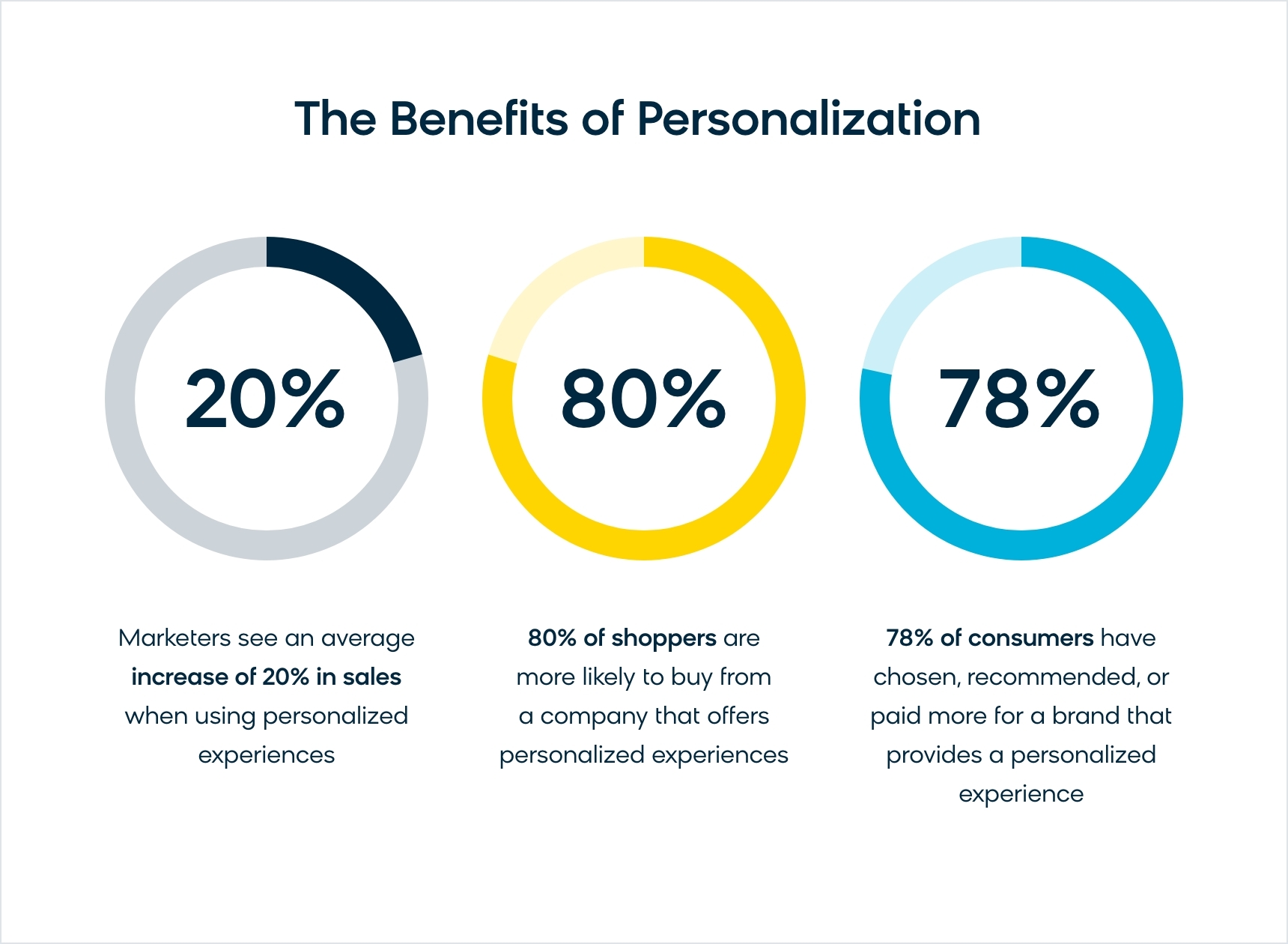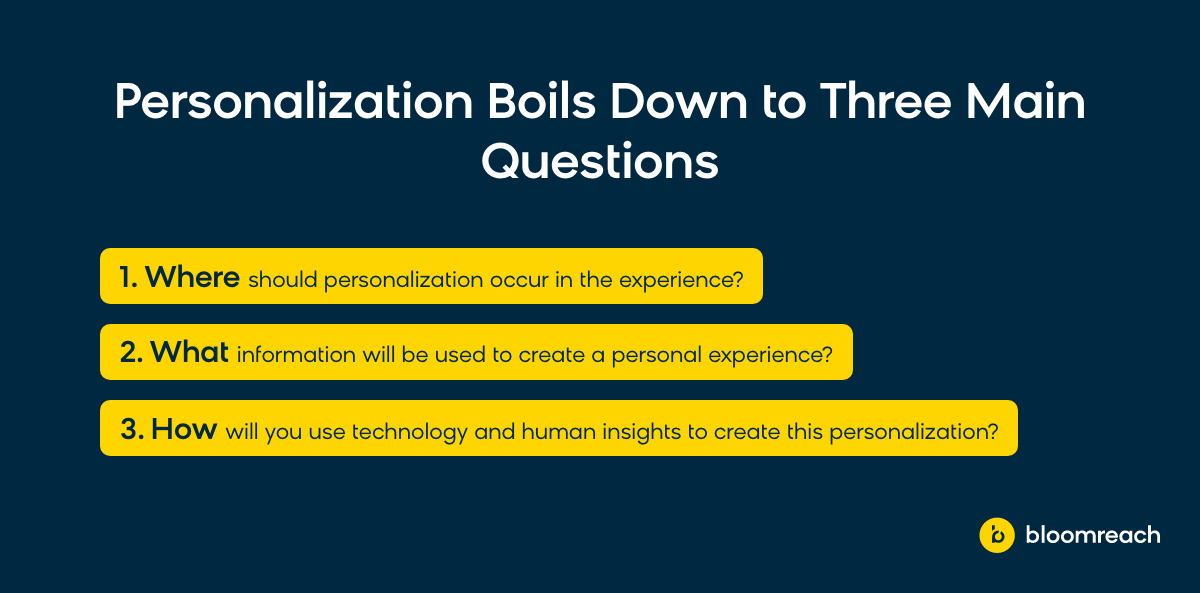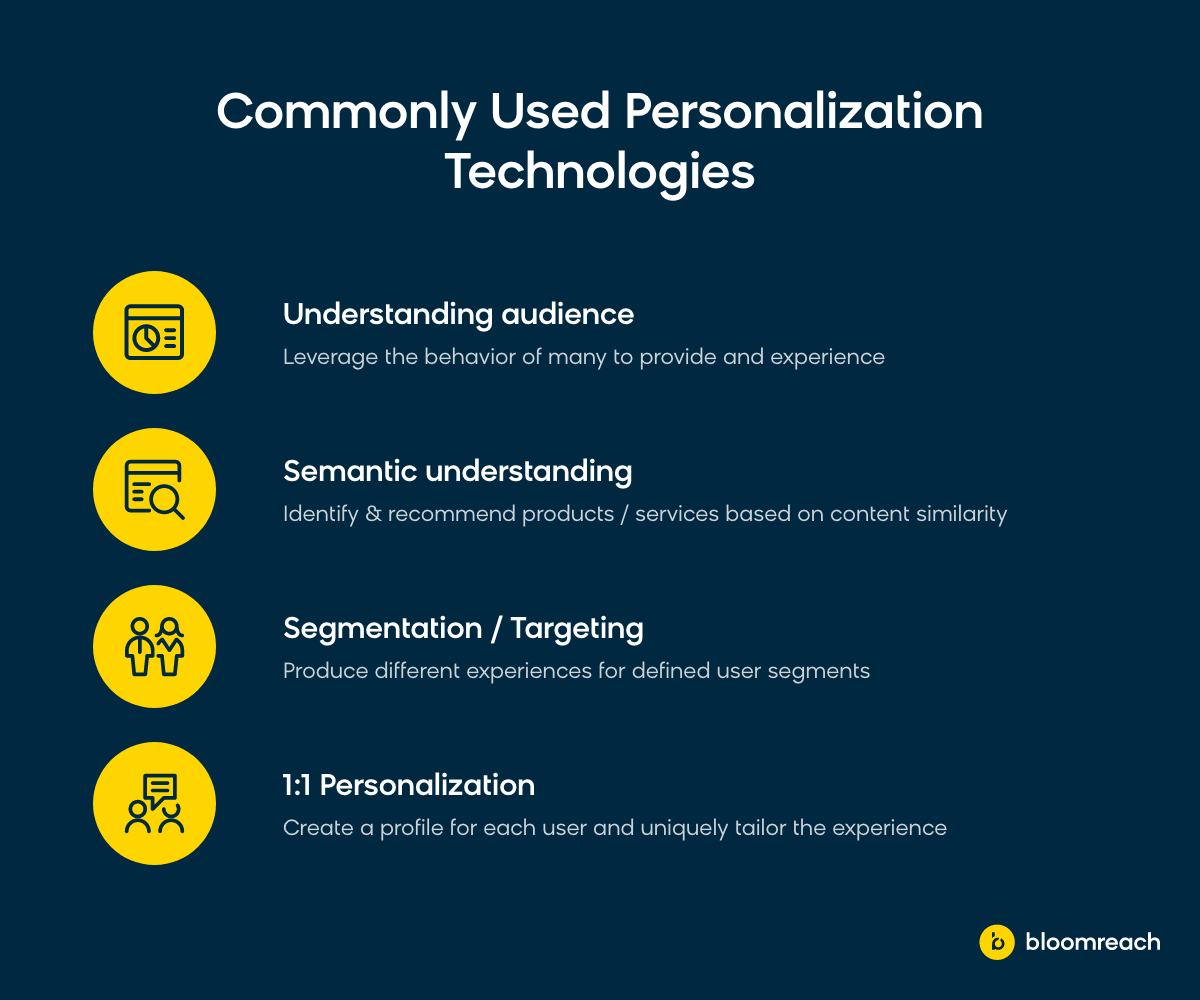Ecommerce Personalization: Your Complete Guide
By Busra Sahin
02/08/2024

Ecommerce personalization has been a key focus for digital business for a long time, with the ultimate ambition being a consistent, cross-channel experience that adapts to customer needs and goals in real time.
The good news for digital commerce is that these technologies have finally arrived. The bad news is the sheer number and variety of technologies now available. Different tactics, levels of personalization, and results mean that each new tool makes how to design and achieve an effective personalized ecommerce experience even less clear.
With the complete Bloomreach guide, you’ll understand exactly what ecommerce personalization is as well as how to use it to optimize your business.
What Is Ecommerce Personalization?
Ecommerce personalization is the practice of using data to understand your customers so you can offer experiences that are so relevant and contextual, they feel like magic. Ecommerce personalization is cross-channel and is driven by real-time, first-party data. It encompasses anonymous as well as known customers and includes messages, content, site layouts, products, and more.
Personalization is increasingly important to merchants seeking to not only engage shoppers, but to also increase repeat purchases, drive sales, and increase conversion.
It comes in many different forms, from personalized product recommendations on a retailer’s homepage or product detail page to cart abandonment marketing emails and onboarding quizzes that provide a personalized showroom of items to consumers.
Benefits of Personalization in Ecommerce
Before the explosion of digital commerce, customers simply walked into stores and found a friendly clerk who helped them find what they wanted.
Pretty simple, right?
Unfortunately, that kind of personal customer attention remains exceedingly rare in the digital realm. Even in the “age of the customer,” retailers, brands, and B2B companies talk a great deal about the need to personalize the customer experience without truly investing in this vital strategy.
Let's take a look at the benefits of ecommerce personalization for businesses.

🔍 Consider these ecommerce personalization stats:
- Marketers see an average increase of 20% in sales when using personalized experiences. (Monetate)
- 80% of shoppers are more likely to buy from a company that offers personalized experiences. (Epsilon)
- 60% of consumers say that they will likely become repeat buyers after a personalized shopping experience with a particular company. (Segment)
- 78% of consumers have chosen, recommended, or paid more for a brand that provides a personalized service or experience. (McKinsey)
- 53% of digital experience delivery professionals said they lack the right technology to personalize experiences. (Forrester)
These are the game-changing facts of personalization — it not only helps your customers achieve their goals while engaging with your brand, but can also align with your business goals when the right strategy is in place. A personalized experience can lead directly to KPIs like increased conversions, average order values, and revenue growth.
And while all these stats prove that consumer attitudes have gravitated towards online shopping for years, COVID-19 accelerated the shift. New habits have formed, and consumers are much more likely to seek out a personalized experience.
As Pam Danziger, luxury retail expert and author, shared in a conversation on steering retail companies through the pandemic, we're going to see even more distinction between the idea of going shopping as an experience and actually having to buy something as we come out of this crisis. The shopping and buying experiences have become disintermediated.
Designing Personalized Ecommerce Experiences
The heart of personalization is goal attainment. As such, the goals you set out for your personalization efforts should be customer driven.
It’s not about simply delivering what your business wants. You need to let visitors consume the experience as they want while you how they prefer and help them achieve their goals at each stage in their journey.
Think of a business you interact with online — your favorite store, your bank, a vacation booking site — and recall the variety of goals you’ve looked to accomplish there.
Your needs from a home goods store may be quite different during wedding season. You relied on your bank for a new set of information when buying a home, and your vacation preferences change depending on whether you're traveling by yourself or with family.
Visitors interact with businesses in a multitude of ways, and truly powerful personalization looks beyond who you are to what you are trying to achieve right now.
Site search, browsing data, product recommendations, landing pages, and all other interaction points should work cohesively to build a complete picture of each visitor across their journey.
Of course, this is easier said than done. While personalization is an increasingly hot topic, most businesses are still in the early stages of understanding how to best utilize it.

When embarking on a new personalization strategy or revamping an existing one, personalization boils down to three main questions:
👉 [Question 1]: Where Should Personalization Occur in the User Experience?
Look at all the channels and touchpoints your customers interact with. Where would a personalized element help the most? Product recommendations, inspirational content, location-based services, site search, customer portals — they can all play a role in creating a seamless customer journey. Mapping out each micro-moment that could benefit from a more contextual experience is an important step in the process.
👉 [Question 2]: What Information Will Be Used?
What tools do you already have — CRM, marketing automation, A/B testing, transactional systems, etc. — that offer a wealth of information? Take your map of where you’d like personalization to occur, decide which of your current tools could help support each micro-moment, and identify the gaps in data you need to fill to complete your vision.
👉 [Question 3]: How Will You Use Technology and Human Insight to Create Ecommerce Product Personalization?
Now comes the fun part: determining how you are going to bring all of your channels and data together to deliver this contextual experience at scale. This is the biggest question of the three, and one we will dive into in more detail in the following specific examples of personalization in ecommerce later onpersonalization examples .
Understanding Ecommerce Personalization Technologies and Tactics
A major issue that digital businesses face when discussing personalization is that there is no single tactic that defines it, and each class of technology comes with limitations.
It’s not as simple as, “We ran an A/B test, and now we are personalized.” There’s a whole spectrum of technologies involved, and creating your personalization roadmap means making your own unique recipe of how much, or how little, you will rely on each one.
The table below contains some of the most common tactics used in both B2C and B2B ecommerce, and each one of these technologies is on the spectrum of personalization. The way forward is to combine each of these ecommerce personalization tools and technologies to build a comprehensive intelligence around user intent.
To get your visitors to their goal of the moment, you need to understand them and tailor your personalized ecommerce experience across every level these technologies offer.
Real-time personalization requires noticing how visitors' behavior differs or aligns with their typical behavior, identifying their current goal through their own behavior and the behavior of similar users, as well as using insights across all levels of technologies to help them accomplish this goal.

[Personalization Tactic #1]: Understanding Audience
Understanding each customer’s need is the very essence of personalization. Satisfying that need takes a blend of the right technology and the knowledge of how to use it.
Whether it’s a new visitor or a familiar customer, you can assemble clues from how they entered your site to determine why they came to you. If you identify that intent immediately, you can shorten their customer journey and enhance their experience.
Did they come from an advertisement on social media? Did they look for a particular product or service on a search engine? Did they find you from a press article?
If you’re lucky enough to have a known visitor that perhaps purchased something or filled out a form, you can display items or content that is related to them.
🔑 Do this:
If you’re a sports retailer and have a customer who entered your site through a search engine with the term “bargain golf clubs,” your landing page could boost some clubs you have on sale along with other low-priced clubs at the top of the product grid.
If you’re an insurance company and customers are visiting via their mobile phone from a country out of your region, you could induce they are likely a client on vacation and show claim information on the homepage.
If you’re an electronics retailer and your visitor recently ordered a laptop, merchandisers may want to display some popular accessories for that computer, like a desktop porting station, an external memory drive, or a carrying case.
Thanks to digital experience platforms and machine learning, you can take care of this at scale and provide the most relevant content and products to your visitors.
[Personalization Tactic #2]: Semantic Understanding for Personalized Search
The relative rarity of personalized search is a huge missed opportunity, as visitors using search convert at a 1.8 times higher rate than the average visitor.
And while the search bar is arguably the most important real estate on any site, search functions unfortunately may hurt as much as they help your customer experience. That's because many search engines focus on keywords instead of the meaning of those words in context.
Search can be messy. Spelling mistakes, use of broad terms, and differences in how people describe the same product can make accurate search results a struggle. On a practical level, these challenges are the difference between dumb search and intelligent search. Most marketing platforms still search for words alone, which is a recipe for failure.
Read this next: Understand Your Customers' Search Queries and Intent (use case)
For instance, if a shopper searches for “budget black laptop,” they probably want a black, low-cost computer. But a keyword search may instead deliver a page of low-cost black accessories for a laptop.
By comparison, an intelligent, semantic search considers the words in context, just as a human sales clerk would.
Intelligent search with semantic understanding capabilities is a huge advantage when it comes to happy customers. Brands, manufacturers, retailers, and distributors need to bring their business into the search engine to create guided, merchandising-driven selling experiences on their own.
Intelligent search solutions:
- Offer a set of selling capabilities beyond the search box
- Enable sellers to promote new products since a customer’s last visit
- Help in-store shoppers locate products on a kiosk
- Promotes add-ons for already-purchased products or products in the shopping cart
This means sellers can deliver personalized experiences and recommendations to customers searching and browsing across landing pages — eliminating the need to combine disparate products from multiple software vendors.
🔑 Do this:
If a user that has shown interest in female products (e.g., skirts, dresses, bikinis, etc.) and then searches for generic terms like “shorts,” “shirt,” “exercise shirt,” or “running shoes,” you can use intelligent site search to give preference to female items in results, as the user is more likely to be female.
The experience of each user is personalized in regard to the preferences that they have shown in the past. This is what semantic search has as its main goal: making it easy for your users to find what they're looking for.
Read this next: Predictive Search: Exploring the Autocomplete Technology and Beyond [blog]
[Personalization Tactic #3]: Targeting and Profiling
You can virtually accompany your visitors while they browse your site, just as a car salesman might walk with a customer around a showroom.
All along the way, a good salesman picks up clues on what kind of car suits his customers, what color they like, what they can afford, and how soon they want the vehicle. Knowing the dealership’s inventory, he can then show them a car that matches their needs.
You can take a very similar approach online and can even use a trick that car dealers can’t: you can remain invisible while you do it.
A key to making this work is to let machine learning and AI process all that information and match it against your inventory in real time.
Not only can machine learning help guide individuals at blazingly fast speeds, but it can also offer options a human might have missed by recognizing patterns in the visitor’s past behavior, or matching them with a segment of buyers that had similar characteristics.
With machine learning and AI capabilities in place, you can even identify entirely new customer segments or ecommerce personalization trends that your team overlooked.
🔑 Do this:
If a clothing retailer knows that customers will soon be looking for festival wear, the retailer can create a landing page and add in the products they believe festival goers will be hunting for.
Machine learning then gets to work, boosting items that are performing well, have more stock available, and align to the visitor's preferences.
Additionally, content marketers might create targeted, inspirational content around regional festivals and let AI provide the right content based on IP locations.
[Personalization Tactic #4]: 1:1 Personalization
Access to data is the first and most important step in great 1:1 personalization. Without ecommerce personalization tools like a customer data platform, which gives you a complete picture of your customers on an individual level, crafting personalized experiences can be a real challenge.
But 1:1 personalization in ecommerce is a powerful tool, and when you do have access to a rich set of data about your customers, it can significantly change the products you show to individual shoppers. It requires rapid data aggregation and analysis, cross-channel deployment, and machine learning optimization, but with those solutions in place, marketers and merchandisers can implement transformative personalized journeys at every touchpoint — including search, browsing, site layout, and content.
🔑 Do this:
You’ve likely seen prompts and recommended products on retail websites before. “You Might Like…” and “Others Also Purchased…” are common prompts on ecommerce websites that signal a product recommendations engine at work. This is a fantastic personalized journey to provide your customers, and it comes to life by utilizing a rich data set.
When search behavior and browsing history drives your recommendations, and AI is in place to ensure that your search is always learning and getting better, you can deliver the most relevant and conversion-driving results to your customers.
For example, if you have a customer who looks at very high heels, then you might suggest shoes with stiletto heels and shoes with four- or five-inch heels.
If a customer browses several Louboutin slingback heels, then dynamic categories might suggest Shoes by Christian Louboutin or Evening Wear Shoes by Christian Louboutin, and display products matching those categories.
Get Started With An Ecommerce Personalization Strategy
[Step 1] Understand where and how you want to personalize for your site visitors. This decision should also be made depending on where the most impact on revenue is to be had with ecommerce personalization will most impact revenue.
[Step 2] Do your research on the available ecommerce personalization technologies and tools out there, and decide on a few to get you started.
[Step 3] Assign enough resources to the project. Decide who will oversee this project and measure its gains.
[Step 4] Define a long-term ecommerce personalization strategy and optimization process.
[Step 5] Start to segment and personalize your site. Figure out which ecommerce personalization use cases (such as product recommendations, personalized newsletters, or contextual personalization) are best for your company and invest heavily in perfecting those.
[Step 6] Continue to track and monitor the results of your strategy. Optimize the process where needed.
[Step 7] Once you're happy with the strategy, begin to scale personalized ecommerce experiences across all channels.
Explore Ecommerce Personalization Examples

Boden
Boden, a British clothing retailer, realized that personalizing the customer journey was the key to its future success. However, the team was working with tools that required a lot of manual work and were therefore time consuming and slow to market for trading changes.
As part of its digital transformation project, Boden looked for a solution that would allow them to use time more wisely and strategically.
With Bloomreach, Boden is now able to build a personalized experience for each of its visitors. The solution is powered by AI, which eliminates time-consuming manual work and offers capabilities in A/B testing, slot-based merchandising, 1:1 personalization, segmentation, analytics, and more.

HellermannTyton
HellermannTyton is the leading manufacturer and supplier of cable management systems represented in 39 countries around the world. It aims to create a more personalized experience for its customers while harmonizing its worldwide systems and data internally.
HellermannTyton was in search of a new content management system (CMS), as its former system did not have the capabilities to support such an ambitious digital communication strategy. It was looking for a solution that could help support its efforts to personalize content for its loyal customers.
Attracted by the strong separation between content maintenance and content delivery, Bloomreach Content was the obvious choice for HellermannTyton.
HellermannTyton built a robust management system, and this set up the foundation for HellermannTyton’s global ecommerce strategy. The site is centered on personalization and incorporates relevance targeting to cluster even unknown audiences and deliver different content to different personas.

My Jewellery
As consumers have become increasingly concerned about data protection, businesses everywhere are becoming cautious about data collection. This includes My Jewellery, a clothing and jewelry retailer based in The Netherlands.
My Jewellery wanted to personalize the customer experience it was giving its loyal customers while respecting their personal data privacy. The best way to do this? Embrace the zero-party data movement.
My Jewellery used Bloomreach Engagement to become an industry leader in the zero-party data collection game. It created an ingenious method for zero-party data collection that is both entertaining to its customer base and respectful to data privacy.
By creating a style profile test — a game that optimizes the customer experience without invading privacy simply by letting customers decide whether or not they like an item that is being shown to them — My Jewellery has upgraded customer personalization, increased customer service, and curbed the need for risk taking in data collection.
My Jewellery’s items are shown sequentially and customers make a decision on each item presented by simply clicking on the heart or X to signify their decision. After a decision is made, My Jewellery is able to offer customers a personal style profile filled with items that individual customers will like based on communicated preferences.
Read this next: My Jewellery Gets Creative With Zero-Party Data and Bloomreach Engagement [case study]
Bloomreach Facilitates Connected Customer Experiences With Ecommerce Personalization
The reality is that in the world of ecommerce, personalization is everything.
It’s what engages customers, inspires them, and keeps them coming back. And getting it right so you can drive that ever-important brand loyalty doesn’t have to be as complicated as it seems, so long as you get your order of operations down. If you start by defining your “personalization purpose,” it will help guide your ecommerce personalization journey, align your commerce-driving team, and ensure there’s a light at the end of the proverbial tunnel of all your personalization efforts.
If you're looking to upgrade your company's personalization efforts and increase customer loyalty, learn how in our use case library. Bloomreach offers a use case for every ecommerce personalization strategy and offers limitless opportunities for growth for ecommerce companies.
Ecommerce customization and personalization is a strategy that most B2B marketers are interested in pursuing. In B2B, purchases are made because the buyer has a specific problem to solve. But it is not a personal, individual problem that ends after their purchase, like in B2C transactions. To make personalized experiences that work for their clientele, B2B companies need to contextualize their site experience with a deep understanding of industries, accounts, and use cases, as well as products. That’s the main difference between B2B and B2C personalization strategies — a contextualized experience based on application rather than customer behavior is crucial.
The increasing accessibility of artificial intelligence (AI) and machine learning has been a major driver of personalization. The future of ecommerce will be powered by AI because of its ability to empower commerce-driving teams to accomplish things that previously were not possible manually. That's because AI can crunch data quickly, enabling real-time optimizations and scalability. Companies can utilize the collected and processed data to recommend personalized products to every customer in real time and thus design an individual, user-oriented shopping experience.
Found this useful? Subscribe to our newsletter or share it.







